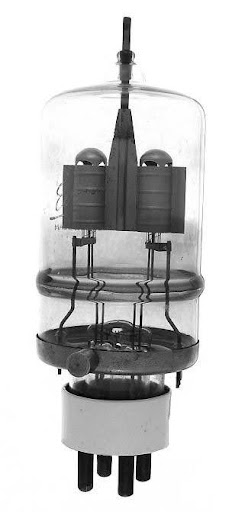by Norm Wilson N6JV – Visit the museum at N6JV.com
152T
In 1938, Eimac started experimenting with paralleling 75T tubes in the same envelope. The earliest form of a two-unit tube was the 152T rated at 150 watts. The grids were connected in parallel but the filaments were separated. Eimac advertised that you could run one triode until it failed and then turn the tube 180 degrees and use the second triode. If both sections were to be used, the filaments could be paralleled and run at 5 volts or in series and operated at 10 volts. The plate had a maximum of 3000 volts at 450 ma. The maximum frequency for full power was 40 MHz. When used as a pulse modulator, the maximum voltage was 18 KV. Subsequent tubes made in WWII had a different envelope shape.

The first example (above) is the oldest example I have ever seen. It has an envelope that slopes to the anode connection and a brown ceramic base. Eimac filed a patent numbered 2,355,717 in February 1941 that illustrated the 152T with an envelope that was flat on top as is shown in the second photo. The original design was probably made in 1940 or before. During the war, the grid connection was made internal and an internal shield was added as seen in the third photo. These tubes were used as pulse modulators in the REL MK IIIC gun laying RADAR and other equipment. The later tubes were designated the 152TH with a mu of 20 and the 152TL with a mu of 12.


